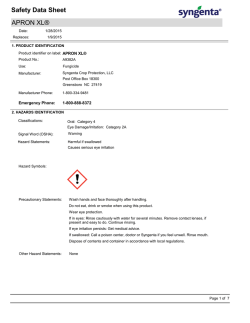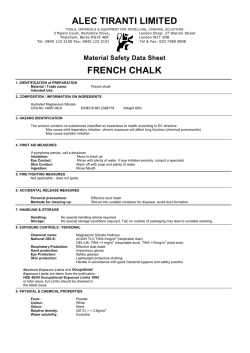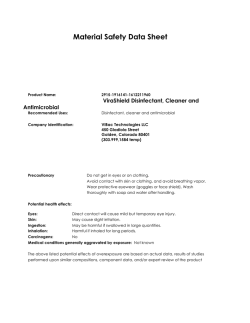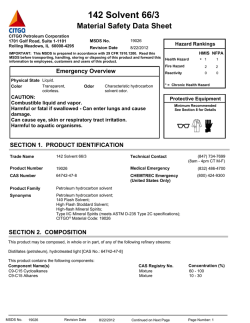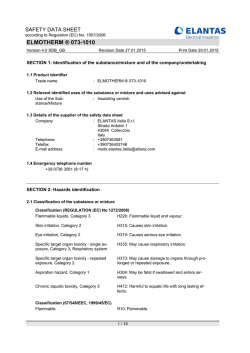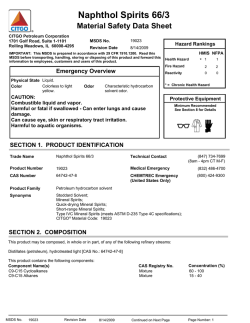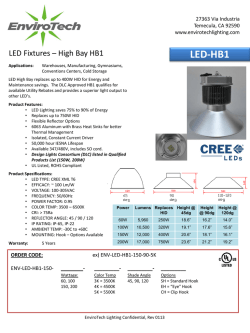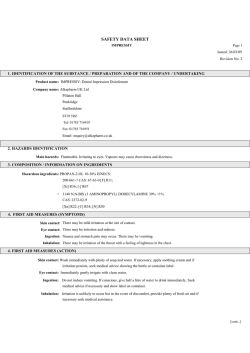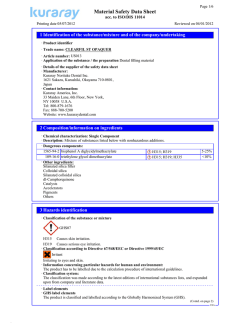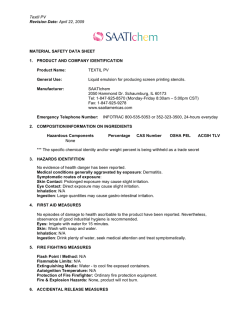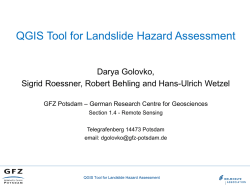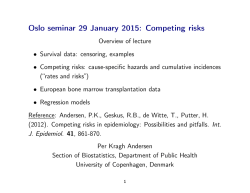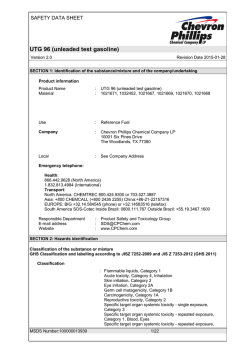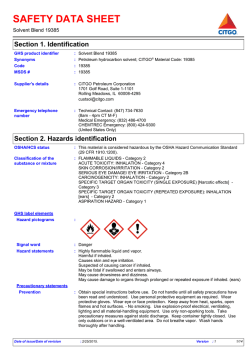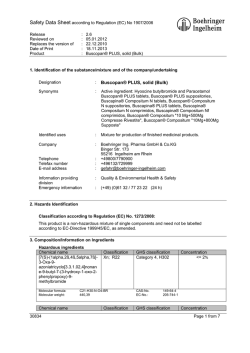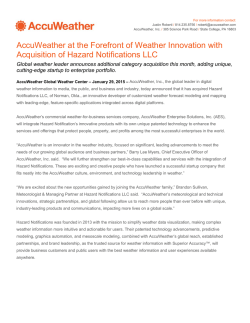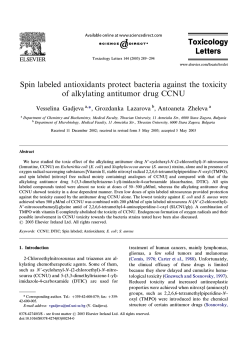
Safety Data Sheet PALISADE® EC
Safety Data Sheet PALISADE® EC Date: Replaces: 1/28/2015 1/22/2013 1. PRODUCT IDENTIFICATION Product identifier on label: PALISADE® EC Product No.: A8981A Use: Growth Inhibitor Manufacturer: Syngenta Crop Protection, LLC Post Office Box 18300 Greensboro NC 27419 Manufacturer Phone: 1-800-334-9481 Emergency Phone: 1-800-888-8372 2. HAZARDS IDENTIFICATION Classifications: Specific Target Organ Toxicity: Repeated Category 2 Specific Target Organ Toxicity: Drowsiness Category 3 Eye Damage/Irritation: Category 2A Specific Target Organ Toxicity: Respiratory Irritation Category 3 Aspiration Hazard: Category 1 Flammable Liquid: Category 4 Carcinogenicity: Category 1B Signal Word (OSHA): Danger Hazard Statements: Combustible liquid May be fatal if swallowed and enters airways Causes serious eye irritation May cause respiratory irritation May cause drowsiness or dizziness May cause cancer May cause damage to organs through prolonged or repeated exposure Hazard Symbols: Precautionary Statements: Obtain special instructions before use. Do not handle until all safety precautions have been read and understood. Keep away from heat, sparks, open flames, hot surfaces. No smoking. Do not breathe mist, vapors, spray. Wash hands and face thoroughly after handling. Use only outdoors or in a well-ventilated area. Page 1 of 9 Safety Data Sheet PALISADE® EC Date: Replaces: 1/28/2015 1/22/2013 Wear protective gloves, protective clothing, eye protection. If swallowed: Immediately call a poison center, doctor or Syngenta. If inhaled: Remove person to fresh air and keep comfortable for breathing. If in eyes: Rinse cautiously with water for several minutes. Remove contact lenses, if present and easy to do. Continue rinsing. If eye irritation persists: Get medical advice. If exposed or concerned: Get medical advice/attention. Call a poison center, doctor or Syngenta if you feel unwell. Do NOT induce vomiting. In case of fire: Use dry chemical, foam or CO2 for extinction. Store in a well-ventilated place. Keep cool. Store locked up. Dispose of contents and container in accordance with local regulations. Other Hazard Statements: None 3. COMPOSITION/INFORMATION ON INGREDIENTS Chemical Name Common Name CAS Number Concentration 1,2,4-Trimethylbenzene 1,2,4-Trimethylbenzene 95-63-6 <10.0% Naphthalene Naphthalene 91-20-3 <15.0% 1,2-Propanediol Propylene Glycol 57-55-6 Trade Secret Mineral Oil Mineral Oil 8042-47-5 Trade Secret Petroleum Solvent Petroleum Solvent Trade Secret Trade Secret Other ingredients Other ingredients Trade Secret >63.0% 4-(Cyclopropyl-a-hydroxymethylene)-3,5dioxo-cyclohexanecarboxylic acid ethylester Trinexapac-Ethyl 95266-40-3 12.0% Ingredients not precisely identified are proprietary or non-hazardous. Values are not product specifications. 4. FIRST AID MEASURES Have the product container, label or Safety Data Sheet with you when calling Syngenta (800-888-8372), a poison contol center or doctor, or going for treatment. Ingestion: If swallowed: Call Syngenta (800-888-8372), a poison control center or doctor immediately for treatment advice. Do not give any liquid to the person. Do not induce vomiting unless told to do so after calling 800-8888372 or by a poison control center or doctor. Do not give anything by mouth to an unconscious person. Eye Contact: If in eyes: Hold eye open and rinse slowly and gently with water for 15-20 minutes. Remove contact lenses, if present, after 5 minutes, then continue rinsing eye. Call Syngenta (800-888-8372), a poison control center or doctor for treatment advice. Skin Contact: If on skin or clothing: Take off contaminated clothing. Rinse skin immediately with plenty of water for 15-20 minutes. Call Syngenta (800-888-8372), a poison control center or doctor for treatment advice. Inhalation: If inhaled: Move person to fresh air. If person is not breathing, call 911 or an ambulance, then give artificial respiration, preferably mouth-to-mouth if possible. Call Syngenta (800-888-8372), a poison control center or doctor for further treatment advice. Page 2 of 9 Safety Data Sheet PALISADE® EC Date: Replaces: 1/28/2015 1/22/2013 Most important symptoms/effects: Eye irritation Drowsiness or dizziness Indication of immediate medical attention and special treatment needed: There is no specific antidote if this product is ingested. Treat symptomatically. Contains petroleum distillate - vomiting may cause aspiration pneumonia. 5. FIRE FIGHTING MEASURES Suitable (and unsuitable) extinguishing media: Use dry chemical, foam or CO2 extinguishing media. If water is used to fight fire, dike and collect runoff. Specific Hazards: Combustible liquid. Can release vapors that form explosive mixtures at temperatures at or above the flash point. Heavy vapors can flow along surfaces to distant ignition sources and flash back. During a fire, irritating and possibly toxic gases may be generated by thermal decomposition or combustion. Special protective equipment and precautions for firefighters: Wear full protective clothing and self-contained breathing apparatus. Evacuate nonessential personnel from the area to prevent human exposure to fire, smoke, fumes or products of combustion. 6. ACCIDENTAL RELEASE MEASURES Personal precautions, protective equipment, and emergency procedures: Follow exposure controls/personal protection outlined in Section 8. Methods and materials for containment and cleaning up: Control the spill at its source. Contain the spill to prevent from spreading or contaminating soil or from entering sewage and drainage systems or any body of water. Clean up spills immediately, observing precautions outlined in Section 8. Cover entire spill with absorbing material and place into compatible disposal container. Scrub area with hard water detergent (e.g. commercial products such as Tide, Joy, Spic and Span). Pick up wash liquid with additional absorbent and place into compatible disposal container. Once all material is cleaned up and placed in a disposal container, seal container and arrange for disposition. 7. HANDLING AND STORAGE Precautions for safe handling: Store the material in a well-ventilated, secure area out of reach of children and domestic animals. Do not store food, beverages or tobacco products in the storage area. Prevent eating, drinking, tobacco use, and cosmetic application in areas where there is a potential for exposure to the material. Wash thoroughly with soap and water after handling. Conditions for safe storage, including any incompatibilities: Store locked up. 8. EXPOSURE CONTROLS/PERSONAL PROTECTION THE FOLLOWING RECOMMENDATIONS FOR EXPOSURE CONTROLS/PERSONAL PROTECTION ARE INTENDED FOR THE MANUFACTURE, FORMULATION AND PACKAGING OF THIS PRODUCT. FOR COMMERCIAL APPLICATIONS AND/OR ON-FARM APPLICATIONS CONSULT THE PRODUCT LABEL. Occupational Exposure Limits: Page 3 of 9 Safety Data Sheet PALISADE® EC Date: Replaces: 1/28/2015 1/22/2013 Chemical Name OSHA PEL ACGIH TLV Other Source 1,2,4-Trimethylbenzene Not Established 25 ppm TWA 25 ppm TWA NIOSH Naphthalene 10 ppm TWA 10 ppm TWA (skin) 10 ppm TWA NIOSH Propylene Glycol Not Established Not Established 10 mg/m³ TWA AIHA Mineral Oil Not Established 5 mg/m³ TWA inhalable Not Established Not Applicable Petroleum Solvent Not Established Not Established 50 mg/m³ (8 ppm) TWA Manufacturer Other ingredients Not Applicable Not Applicable Not Applicable Not Applicable Trinexapac-Ethyl Not Established Not Established 10 mg/m³ TWA Syngenta Appropriate engineering controls: Use effective engineering controls to comply with occupational exposure limits (if applicable). Individual protection measures: Ingestion: Prevent eating, drinking, tobacco usage and cosmetic application in areas where there is a potential for exposure to the material. Wash thoroughly with soap and water after handling. Eye Contact: Where eye contact is likely, use chemical splash goggles. Facilities storing or utilizing this material should be equipped with an eyewash facility and a safety shower. Skin Contact: Where contact is likely, wear chemical-resistant gloves (such as barrier laminate or Viton), coveralls, socks and chemicalresistant footwear. Inhalation: A combination particulate/organic vapor respirator should be used until effective engineering controls are installed to comply with occupational exposure limits, or until exposure limits are established. Use a NIOSH approved respirator with an organic vapor (OV) cartridge or canister with any R, P or HE filter. Use a self-contained breathing apparatus in cases of emergency spills, when exposure levels are unknown, or under any circumstances where air-purifying respirators may not provide adequate protection. 9. PHYSICAL AND CHEMICAL PROPERTIES Appearance: Amber liquid Odor: Aromatic Odor Threshold: Not Available pH: 3 - 5 (1% solution in H2O @ 77°F (25°C)) Melting point/freezing point: Not Available Initial boiling point and boiling range: Not Available Flash Point (Test Method): 185°F (Closed Cup) Flammable Limits (% in Air): Not Available Flammability: Combustible liquid Vapor Pressure: Trinexapac-Ethyl 1.6 x 10(-5) mmHg @ 77°F (25°C) Page 4 of 9 Safety Data Sheet PALISADE® EC Date: 1/28/2015 Replaces: 1/22/2013 Vapor Density: Not Available Relative Density: 0.9868 - 1.0068 g/ml ; 8.31 lbs/gal Solubility (ies): Trinexapac-Ethyl 10.2 g/l @ 77°F (25°C) Partition coefficient: n-octanol/water: Not Available Autoignition Temperature: Not Available Decomposition Temperature: Not Available Viscosity: Not Available Other: None 10. STABILITY AND REACTIVITY Reactivity: Not reactive. Chemical stability: Stable under normal use and storage conditions. Possibility of hazardous reactions: Conditions to Avoid: Will not occur. Not Available Incompatible materials: None known. Hazardous Decomposition Products: Not Available 11. TOXICOLOGICAL INFORMATION Health effects information Likely routes of exposure: Symptoms of exposure: Dermal, Inhalation Eye irritation, Drowsiness or dizziness Delayed, immediate and chronic effects of exposure: Possible carcinogenicity, Eye irritation, Drowsiness or dizziness Numerical measures of toxicity (acute toxicity/irritation studies (finished product)) Ingestion: Oral (LD50 Rat) : 5130 mg/kg body weight Dermal: Dermal (LD50 Rabbit) : > 2020 mg/kg body weight Inhalation: Inhalation (LC50 Rat) : > 2.7 mg/l air - 4 hours Eye Contact: Moderately Irritating (Rabbit) Skin Contact: Slightly Irritating (Rabbit) Skin Sensitization: Not a Sensitizer (Guinea Pig) Reproductive/Developmental Effects Trinexapac-Ethyl: None observed. Page 5 of 9 Safety Data Sheet PALISADE® EC Date: Replaces: 1/28/2015 1/22/2013 Chronic/Subchronic Toxicity Studies Trinexapac-Ethyl: Liver, kidney and brain (dogs) effects at high doses (>5000 ppm). Carcinogenicity Trinexapac-Ethyl: Slight increase in forestomach tumors in male rats at high doses (20000 mg/kg/day). Not applicable to humans. Chemical Name NTP/IARC/OSHA Carcinogen 1,2,4-Trimethylbenzene No Naphthalene See "Toxicity", Sec. 11 1,2-Propanediol No Mineral Oil No Petroleum Solvent No Other ingredients No 4-(Cyclopropyl-a-hydroxymethylene)-3,5dioxo-cyclohexanecarboxylic acid ethylester No Other Toxicity Information None Toxicity of Other Components 1,2,4-Trimethylbenzene Inhalation of 1,2,4-trimethylbenzene at high concentrations can cause central nervous system depression, respiratory tract irritation, asphyxiation, cardiac stress and coma. Effects of chronic exposure to this solvent can include blood disorders (anemia, leukopenia) and kidney or liver damage. Mineral Oil May cause respiratory irritation when inhaled as a mist. Naphthalene Exposure to naphthalene can cause cataracts, liver damage, kidney failure, respiratory failure, hematuria, anemia, damage to red blood cells, leukocytosis, or coma. Carcinogen Status: NTP: Anticipated Carcinogen IARC: Group 2B Possible Human Carcinogen Other ingredients Not Applicable Petroleum Solvent Repeated exposure may case skin dryness or cracking. If swallowed, may be aspirated and cause lung damage. May be irritating to the eyes, nose, throat and lungs. Breathing of high vapor concentrations may cause central nervous system (CNS) depression resulting in dizziness, light-headedness, headache, nausea and loss of coordination. Propylene Glycol Reported to cause central nervous system depression (anesthesia, dizziness, confusion), headache and nausea. Also, eye irritation may occur with lacrimation but no residual discomfort or injury. Prolonged contact to skin may cause mild to moderate irritation and possible allergic reactions. Chronic dietary exposure caused kidney and liver injury in experimental animals. Target Organs Active Ingredients Trinexapac-Ethyl: Inert Ingredients 1,2,4-Trimethylbenzene: Liver, kidney, brain CNS, liver, kidney, blood, respiratory tract, skin, eye Page 6 of 9 Safety Data Sheet PALISADE® EC Date: 1/28/2015 Replaces: 1/22/2013 Mineral Oil: Respiratory tract Naphthalene: Eye, liver, kidney, respiratory tract, blood, CNS Other ingredients: Not Applicable Petroleum Solvent: Respiratory tract, stomach, liver, thyroid, urinary bladder, CNS, skin Propylene Glycol: CNS, kidney, liver 12. ECOLOGICAL INFORMATION Eco-Acute Toxicity Trinexapac-Ethyl: Fish (Rainbow Trout) 96-hour LC50 65.7 ppm Green Algae 5-day EC50 < 1.4 ppm Invertebrate (Water Flea) Daphnia Magna 48-hour EC50 > 142.5 ppm Bird (Mallard Duck) 14-day LD50 > 2000 mg/kg Environmental Fate Trinexapac-Ethyl: The information presented here is for the active ingredient, trinexapac-ethyl. Low bioaccumulation potential. Not persistent in soil or water. Moderate mobility in soil. Sinks in water (after 24 h). 13. DISPOSAL CONSIDERATIONS Disposal: Do not reuse product containers. Dispose of product containers, waste containers, and residues according to local, state, and federal health and environmental regulations. Characteristic Waste: Not Applicable Listed Waste: Not Applicable 14. TRANSPORT INFORMATION DOT Classification Ground Transport - NAFTA Containers < 119 gallons cap.: Not regulated Containers > 119 gallons cap.: Proper Shipping Name: RQ, Combustible Liquid, N.O.S. (Naphthalene) Hazard Class: Combustible Liquid Identification Number: NA 1993 Packing Group: PG III Comments Water Transport - International Proper Shipping Name: Environmentally Hazardous Substance, Liquid, N.O.S. (Trinexapac-Ethyl), Marine Pollutant Hazard Class: Class 9 Identification Number: UN 3082 Packing Group: PG III Air Transport Proper Shipping Name: Environmentally Hazardous Substance, Liquid, N.O.S. (Trinexapac-Ethyl) Hazard Class: Class 9 Identification Number: UN 3082 Packing Group: PG III Page 7 of 9 Safety Data Sheet PALISADE® EC Date: 1/28/2015 Replaces: 1/22/2013 15. REGULATORY INFORMATION Pesticide Registration: This chemical is a pesticide product registered by the Environmental Protection Agency and is subject to certain labeling requirements under federal pesticide law. These requirements differ from the classification criteria and hazard information required for safety data sheets, and for workplace labels of non-pesticide chemicals. Following is the hazard information as required on the pesticide label: Warning: Causes substantial but temporary eye injury. Do not get in eyes or on clothing. Wear protective eyewear such as goggles, face shield, or safety glasses. Harmful if swallowed, inhaled, or absorbed through skin. Avoid contact with skin, eyes or clothing. Avoid breathing vapor or spray mist. EPA Registration Number(s): 100-949 EPCRA SARA Title III Classification: Acute Health Hazard Section 311/312 Hazard Classes: Fire Hazard 1,2,4-Trimethylbenzene <10.0% (CAS No. 95-63-6) Section 313 Toxic Chemicals: Naphthalene <15.0% (CAS No. 91-20-3) CERCLA/SARA 304 Reportable Quantity (RQ): Report spills > 125 gal. (based on naphthalene [RQ= 100 lbs] content in formulation). RCRA Hazardous Waste Classification (40 CFR 261): Not Applicable TSCA Status: Exempt from TSCA, subject to FIFRA 16. OTHER INFORMATION HMIS Hazard Ratings NFPA Hazard Ratings Health: Flammability: Instability: 2 2 0 Health: Flammability: Reactivity: 1 2 0 Syngenta Hazard Category: B,S 0 1 2 3 4 * Minimal Slight Moderate Serious Extreme Chronic For non-emergency questions about this product call: 1-800-334-9481 Original Issued Date: Revision Date: Section(s) Revised: 3/3/1999 1/28/2015 Replaces: 1/22/2013 1-16 Page 8 of 9 Safety Data Sheet PALISADE® EC Date: 1/28/2015 Replaces: 1/22/2013 The information and recommendations contained herein are based upon data believed to be correct. However, no guarantee or warranty of any kind, expressed or implied, is made with respect to the information contained herein. Page 9 of 9
© Copyright 2025
